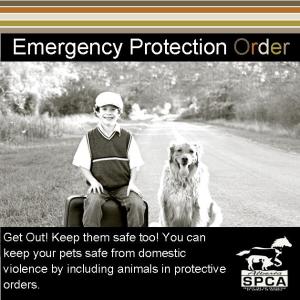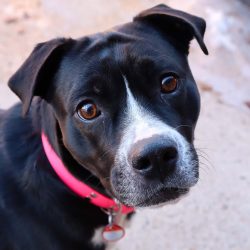This guest post today comes from the Alberta SPCA. For November – Family Violence Prevention Month in Alberta – the Alberta SPCA has been posting information on family violence and the impact on animals.
 Animals are important to people—livestock can provide income, and pets give us comfort. We often think of pets as part of the family. Legally, though, they’re not considered family members. Instead, they are technically considered “property.” As a result, they are often overlooked in protection orders, as it is said that it is inappropriate to consider the division of property in protection orders. However, pets and livestock are not mere property: they are not like a television or a car, and their well-being can be extremely relevant for the protection of a victim of domestic violence.
Animals are important to people—livestock can provide income, and pets give us comfort. We often think of pets as part of the family. Legally, though, they’re not considered family members. Instead, they are technically considered “property.” As a result, they are often overlooked in protection orders, as it is said that it is inappropriate to consider the division of property in protection orders. However, pets and livestock are not mere property: they are not like a television or a car, and their well-being can be extremely relevant for the protection of a victim of domestic violence.
Abusers often threaten pets or livestock to control their victims and make them stay. And it works.
In a 2012 Alberta SPCA study, most pet-owning women in emergency shelters (59%) delayed leaving the abusive situation out of concern for their pets or livestock. More than one-third reported that their animals were threatened by the abuser – and those threats were carried out
85% of the time.
Children are also affected. Most of the time, children witness or know about the animal abuse, and in half of the situations it’s the child’s own
pet that is threatened or harmed.
Alberta’s Protection Against Family Violence Act (PAFVA) states that, when making anEmergency Protection Order (EPO), a judge can consider “any other provisions […] necessary to provide for the immediate protection” of the victim (section 2[30(g)]). If the animals’ protection is necessary to quickly get victims to safety, then that protection fits under the PAFVA concept of “any other provision.”
Similarly, when making Queen’s Bench Protection Orders (QBPO), section 4(2)(m) of PAFVA, allows for “any provision that the Court considers appropriate.” As the Alberta SPCA study shows, concern for pets or livestock can—and often does—affect the ability of victims to leave abusive relationships. Furthermore, in many cases those concerns arose from expressed threats made by the abusive partner towards the animal. Victims are at risk longer because of their concern for the animals.
For more information on protective orders download the Get Out and Keep Them Safe, too! brochure. You can do something about it.
If you have cause to believe there is animal abuse occurring in your community, you should report it to the appropriate SPCA or humane society for your area.





